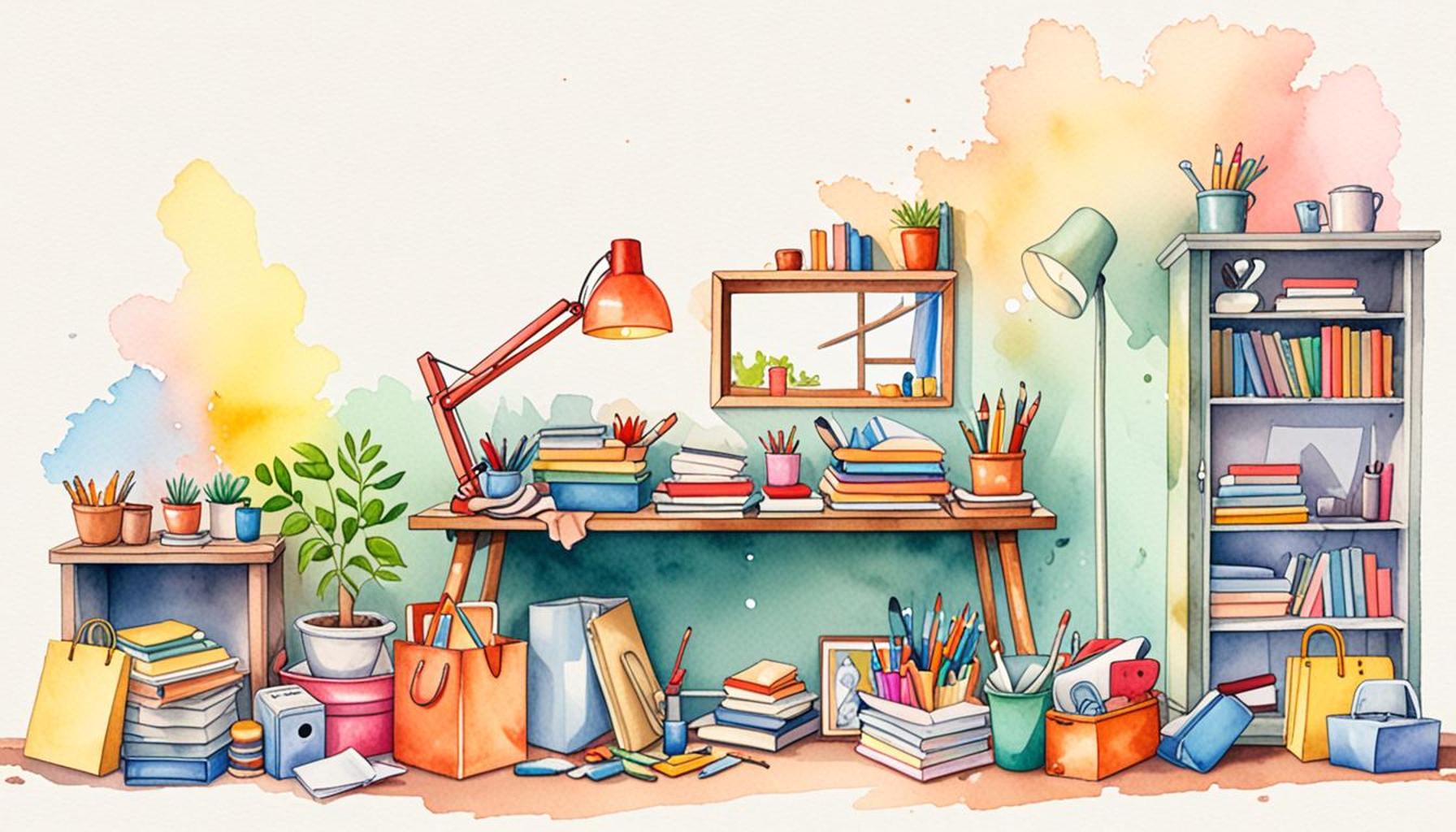The Art of Letting Go: Decluttering Techniques for Beginners

The Importance of Letting Go
In the relentless pace of modern life, where it seems that consumerism prevails, the accumulation of belongings often becomes a burden. The clutter in our homes serves not merely as a distraction but as a barrier to achieving mental clarity. Our physical environments significantly influence our emotional states; thus, letting go of the clutter is not just a decluttering task—it is a powerful act that can lead to mental clarity and emotional freedom.
As the minimalist movement gains traction, many individuals in the United States have begun to explore practical strategies to reclaim their living spaces and, ultimately, their lives. By employing these strategies, one can more easily navigate the often daunting process of decluttering. Here are some effective techniques tailored for beginners:
- The 30-Day Rule: This method encourages gradual decluttering. On day one, you part with one item; on day two, two items; and so forth until you reach thirty items by day thirty. This progressive approach makes the task less overwhelming and instills a sense of accomplishment.
- Four-Box Method: Sorting items into four labeled boxes—”Keep,” “Donate,” “Trash,” and “Repair”—can streamline the decluttering process. This method forces you to make decisions about your belongings, often revealing how many items are no longer needed.
- Seasonal Decluttering: With each new season, reassessing your belongings can be liberating. If you haven’t used certain items in the past few months, consider letting them go. This exercise not only clears your space but can also make room for new seasonal items.
Embracing these straightforward techniques can lead to a remarkable transformation in your home and a profound shift in your mindset. Research indicates that taking control of physical space is associated with reduced stress levels and enhanced productivity. For many individuals, the process of decluttering serves as the opening chapter in a broader narrative of personal growth and fulfillment.
If you’re ready to explore deeper into the art of letting go, this journey offers opportunities to discover personalized techniques and insights tailored to your unique situation. Whether you’re considering a simple closet cleanout or a comprehensive overhaul of your living space, now is the opportune moment to create a home that reflects the life you genuinely desire. By making room for the essentials, you’re not just reshaping your environment—you’re transforming your entire outlook on life.
DISCOVER MORE: Click here to optimize your workspace
Unlocking Peace of Mind Through Decluttering
Understanding the art of letting go is essential for anyone looking to create a space that feels more open and inviting. The initial step in this journey often involves recognizing the emotional ties we have to our possessions. Many people struggle with the question: “What if I need this later?” This fear often leads to the retention of items that no longer serve a purpose. However, it’s crucial to shift our mindset from one of scarcity to one of abundance—realizing that we can find value and fulfillment in a simpler existence.
To successfully navigate the decluttering process, consider implementing these initial strategies that lay the groundwork for a more organized and mindful living space:
1. Start Small
As with any significant change, a practical starting point can make a world of difference. Begin with a small area of your home, such as a single drawer or a closet shelf. This manageable approach prevents feelings of overwhelm and discouragement, fostering a positive momentum. As you achieve small victories, you’ll gain confidence to tackle larger spaces.
2. Use a Timer
Setting a timer for short intervals—15 or 30 minutes—can transform the decluttering process into a focused, efficient exercise. By dedicating time specifically to sorting through items, you can maintain concentration and reduce the tendency to dwell on each item for too long. This technique helps to create a sense of urgency and accomplishment, spurring you into action.
3. Employ the “Last Used” Rule
A practical guideline is to consider the last time you used an item. If you haven’t touched it in over six months, it might be time to let it go. This method encourages a practical evaluation of your belongings and can help to highlight which items genuinely add value to your life.
4. The Emotional Check-In
While decluttering can be a logical exercise, it often comes down to emotions. Before parting with an item, ask yourself how it makes you feel. If it sparks joy or holds significant value, it may deserve a place in your life. Conversely, if it evokes negative feelings or memories, it may be more beneficial to release it. This emotional check-in not only aids in decluttering but also enhances self-awareness.
By incorporating these techniques into your routine, you will not only notice a physical transformation in your space but also an uplifting change in your mental state. Embracing the art of letting go can pave the way for personal growth, reduced anxiety, and a clearer focus on what truly matters in life. Each item you release represents a step towards a more fulfilling lifestyle free from excess baggage, both material and emotional.
As you embark on this journey of decluttering, remember that the ultimate goal is to create a home that resonates with your personal values and aspirations. The process may be challenging, but with perseverance and the right techniques, you will discover that letting go can be deeply liberating.
| Advantage | Details |
|---|---|
| Enhanced Focus | Clutter can be distracting, making it difficult to concentrate on important tasks. By implementing decluttering techniques, individuals can create an environment that promotes productivity and mental clarity. |
| Emotional Well-Being | Letting go of possessions can lead to a sense of relief and freedom. Techniques for decluttering encourage mindfulness, allowing individuals to face their attachments and ultimately cultivate a lighter emotional state. |
In the realm of decluttering, techniques such as the “one-in-one-out” rule or setting time limits for sorting items can be practical starting points for beginners. By gradually integrating these methods into daily life, individuals can transform their living spaces and, importantly, their state of mind. This journey of decluttering is not just about creating physical space; it’s a process that often fosters personal growth and a deeper understanding of what truly matters. Exploring strategies tailored to the individual can heighten motivation and commitment, making the transition smoother. For instance, visualizing a serene living space can inspire action, while documenting progress through images can provide accountability and motivation. As new habits form, decluttering can become a lifestyle choice rather than a one-time event, allowing an individual to embrace the art of letting go fully.
CHECK THIS OUT: Click here to discover how to enhance your workspace
Finding Freedom in Minimalism
As you delve deeper into the art of letting go, the philosophy of minimalism can serve as a guiding principle. Minimalism advocates for intentional living by focusing on what truly matters while discarding the superfluous. This ideology pushes individuals to reassess their priorities, aligning their environments with their values and lifestyles.
5. The Four-Box Method
One effective approach in decluttering is the four-box method. This technique involves labeling four boxes as ‘Keep’, ‘Donate’, ‘Sell’, and ‘Trash’. As you sift through your belongings, categorize each item into its respective box. This visual strategy not only simplifies decision-making but also provides clarity on the items that are essential versus those that may find a new home or are simply ready for disposal. Many people in the United States find that having clear categories helps to streamline the process and prevent second-guessing.
6. One In, One Out Rule
To maintain a decluttered space, consider adopting the one in, one out rule. Whenever you acquire a new item, commit to removing an old one. This approach can drastically reduce accumulation and encourages a more mindful consideration of purchases. Think twice before buying that new gadget or piece of clothing; it could mean parting with something you already own, which reinforces the core principles of decluttering.
7. Enlist a Friend
Sometimes, the journey of decluttering can feel isolating or overwhelming, making it beneficial to enlist a friend for support. Not only does having an extra set of hands help tackle larger spaces, but it turns the process into a communal experience, filled with laughter, stories, and shared perspectives. Friends often provide an outsider’s view that can assist in making decisions—what you deem as sentimental may be less significant to someone outside your emotional attachment. Plus, you might discover someone willing to take on items that you are struggling to let go of.
8. Digital Decluttering
In an increasingly digital world, decluttering shouldn’t be limited to physical objects. Digital clutter can take the form of overflowing email inboxes, forgotten apps on smartphones, or disorganized photo libraries. Start by unsubscribing from newsletters you no longer read, deleting unused apps, and backing up important files while discarding the unnecessary ones. This can lead to a smoother digital experience, contributing to an overall sense of clarity and focus in your life.
Incorporating these techniques not only fosters a cleaner home but also influences your mental well-being. A decluttered space can enhance productivity, boost creativity, and invite tranquility. With every step you take toward creating a more mindful environment, you’ll discover how the art of letting go extends beyond material possessions, influencing your emotional landscape and interpersonal relationships.
Ultimately, the journey of decluttering is as much about shifting your mindset as it is about physically organizing your space. By adopting these techniques and embracing a lifestyle of less, you can unlock new levels of peace, creativity, and contentment in accordance with your personal journey toward simplicity.
DISCOVER MORE: Click here to dive deeper
Embracing the Journey of Letting Go
As we reach the conclusion of our exploration into the art of letting go, it becomes evident that decluttering is more than just tidying up a physical space; it is a transformative journey towards self-awareness and intentional living. By employing strategies such as the four-box method, the one in, one out rule, and the support of friends, beginners can navigate the often-daunting task of decluttering with confidence and clarity.
Furthermore, recognizing the importance of digital decluttering is increasingly relevant in our fast-paced, tech-driven world. By streamlining both our physical and digital environments, we pave the way for a life enriched with focus, productivity, and peace. Not only does this process help eliminate the chaos that can cloud our minds, but it also invites a sense of clarity that can enhance our emotional well-being and relationships.
In essence, the art of letting go challenges us to shift our priorities, allowing us to align our surroundings with our values and desires. By embracing a more minimalist approach, we create spaces that reflect what truly matters to us, igniting creativity and fostering deeper connections. As you embark on your own decluttering journey, remember that it is a process worth the effort—a chance to foster a lifestyle of simplicity, purpose, and newfound freedom.
So, take the first step today. Discover how the art of letting go can not only refresh your space but also rejuvenate your spirit, inviting endless possibilities into your life.



